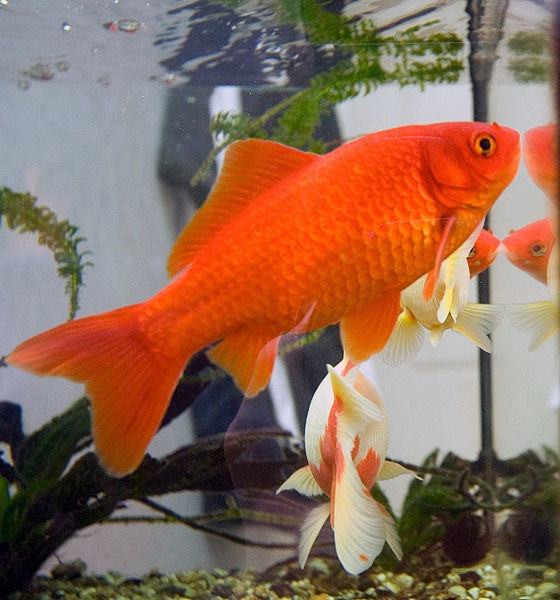Concerns over the use of goldfishes (Carassius auratus) as a food item for reptiles and amphibians have long been recognized, yet there remains a bit of confusion on the topic. References to Vitamin E deficiencies in animals kept on fish-based diets, a separate problem entirely, often further clouds the issue. Prompted by recent comments on our blog, I thought I might address the subject in this article.
Goldfishes and Large Pets
 The controversy is important because goldfishes are the least expensive and most readily available “feeder fish”. They are also available in a wide variety of sizes, allowing owners of large reptiles and amphibians to offer their pets a whole fish, and a more substantial meal than a large golden shiner. This is preferable, from a nutritional standpoint, to feeding cut pieces of a Tilapia or other large food-market fish.
The controversy is important because goldfishes are the least expensive and most readily available “feeder fish”. They are also available in a wide variety of sizes, allowing owners of large reptiles and amphibians to offer their pets a whole fish, and a more substantial meal than a large golden shiner. This is preferable, from a nutritional standpoint, to feeding cut pieces of a Tilapia or other large food-market fish.
A Valuable Resource for Live-Food Specialists
Goldfishes are also quite hardy and usually remain alive when introduced into an aquarium, even when subjected to large temperature changes (drastic temperature changes quickly kill other typical feeder fishes, such as golden shiners and fathead minnows). This allows us to more easily feed aquatic live-food specialists, such as mata mata turtles and tentacled snakes, and American bullfrogs and other large amphibians.
I once cared for a large, wild-caught alligator snapping turtle that refused to eat fishes unless, as in nature, they investigated his tongue’s “fishing lure”. Goldfishes adjusted so well to the exhibit’s water that they would try to eat the turtle’s worm-like lure in short order.
The Origin of the Goldfish Problem
I was fortunate in having been involved in the specific incident that led to the discovery of the nutritional problems associated with goldfish-based diets. During my early years at the Bronx Zoo, it was noticed that mata mata turtles (Chelus fimbriatus) that were fed solely upon goldfish thrived for about 5 years, and then died suddenly. The odd phenomenon, it turned out, was not limited to the Bronx Zoo, and had occurred in several other collections.
Necropsies of the turtles revealed liver and kidney damage, and problems indicative of Vitamin A overdose (this last was later disputed, and has not been proven conclusively).
Using Goldfishes
 Experience has since established that goldfishes may be safely fed to reptiles and amphibians on an occasional basis, i.e. once monthly, but should not be used as a dietary staple.
Experience has since established that goldfishes may be safely fed to reptiles and amphibians on an occasional basis, i.e. once monthly, but should not be used as a dietary staple.
Another Concern?
Some years ago, I came to learn that some commercial goldfish farms raised their stock largely on chicken droppings supplied by local poultry farms (goldfishes, it seems, are quite hardy…and goldfish farm owners equally resourceful!). I do not know if this is still the case, but often wondered about the possibility of Salmonella contamination. I’ve never run across or read of a problem…but looking into it might make for an interesting project.
Further Reading
Please check out the following article for another experienced turtle keeper’s view on goldfishes as a food item, and for a description of the mata mata turtle’s unique strategy of “herding” fishes and other prey.
http://www.tortoise.org/archives/matamata.html.
 That Reptile Blog – Reptile, Amphibian and Exotic Pet Care and Information
That Reptile Blog – Reptile, Amphibian and Exotic Pet Care and Information

 Bent-toed geckos (Genus Cyrtodactylus, i.e. C. louisiadensis and C. irianjayaensis) are becoming ever more popular in captivity but, while a fascinating group, their care is often fraught with difficulties, and there is a great deal of conflicting information being circulated. A recent note from blog reader Dave, upon whom I can always count for interesting comments and questions, brought these wonderful creatures to mind again.
Bent-toed geckos (Genus Cyrtodactylus, i.e. C. louisiadensis and C. irianjayaensis) are becoming ever more popular in captivity but, while a fascinating group, their care is often fraught with difficulties, and there is a great deal of conflicting information being circulated. A recent note from blog reader Dave, upon whom I can always count for interesting comments and questions, brought these wonderful creatures to mind again. I have raised spotted and red salamanders and green, bronze and leopard frogs from metamorphosis through adulthood on an earthworm-only diet, and use them for 50-75% of the diets of many other amphibians. Although refused by many lizards (but relished by American and European glass lizards), earthworms are taken by most predatory reptiles.
I have raised spotted and red salamanders and green, bronze and leopard frogs from metamorphosis through adulthood on an earthworm-only diet, and use them for 50-75% of the diets of many other amphibians. Although refused by many lizards (but relished by American and European glass lizards), earthworms are taken by most predatory reptiles.